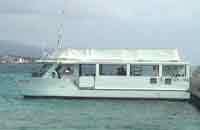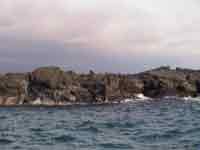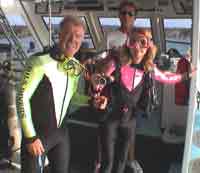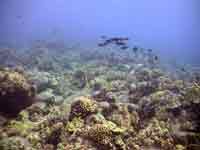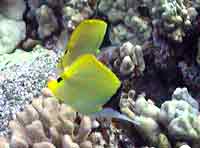 |
||||||||||||||||||||||
Today we are making our first ever boat dive in Hawaii! We are diving with Eco-Adventures, Hawaii's number one scuba diving and adventure company. We meet the dive boat at the dock with all of our dive gear and camera equipment. The dive boat is a 50 foot long, twin hull boat with a sun deck. The boat is specially made for scuba diving. It has seats that have scuba air tank holders built into the backs. Onboard we meet the captain and divemaster, Captain Roger. Captain Roger tells us that we are going to a place called Manta Ray Village. It is called Manta Ray Village because manta rays come here to feed at night. We probably won't see any mantas because we will just be diving during the day. Captain Roger is taking us here so we can see what this looks like during the day, because tomorrow night we will be coming back here to dive with the manta rays. We arrive at the dive site after a 20 minute boat ride. Even though we anchor close to shore we can see that this is not a place where we could dive from the beach like yesterday. The shore is all jagged black lava rock. It was formed when molten lava ran off the land and into the ocean. It would be too rough to walk on. We would also probably get cut up if we got pushed up against it while we were getting in and out of the water. Captain Roger helps us as we get ready to make our dive. With all of our scuba equipment on we stand on the side of the boat. Then we take a big step off the side of the boat and enter the water with a big splash. As we slowly sink toward the bottom we notice that the water is clearer here then our beach dive yesterday. The underwater visibility is about 80 feet. The old lava here is covered with mostly small healthy clumps of corals. We see many different kinds of algae-eating fish and a few spiny black sea urchins about the size of ping-pong balls. We don't see a lot of algae, so it seems that the fish and urchins are doing a good job at preventing the algae from covering the corals. The bottom here is about 20 feet deep. The reefs slopes very gradually to about 40 feet, then it drops off like a cliff down to 80 feet. The bottom at the base of the reef is sand. We don't go to the bottom because we don't see any corals on the sandy bottom. As we slowly swim across the reef we look for sea anemones, because clownfish often live in sea anemones. Unfortunately we can't find any sea anemones or clownfish. We do see one of Nemo's friends from the aquarium, Tess. Tess is a pretty butterflyfish. Butterflyfish get their name from how they swim. They swim from coral to coral, like a butterfly flies from flower to flower. We can see many different kinds of butterflyfish on this reef. Tess is a type of butterflyfish called a longsnout butterflyfish. A longsnout butterflyfish looks like it has a long nose. It is actually the fish's mouth! With its long skinny mouth it can reach down between the corals and catch little animals hiding there, like tiny crabs and worms. The pretty yellow and black longsnout butterflyfish are swimming in pairs. Each pair of fish is a male and female. They are about 5 inches long and don't seem to mind us getting close to them to take their picture. Even though we know that one of the fish in the pair is a female and one is a male, we can't tell which is which. They both look the same and are the same size! We follow the butterflyfish around the reef and watch as they stop to nibble between the corals. They are fun to watch because they always make sure they know where their partner is. If they lose track of their partner they quickly swim around the coral until they find each other again. They act like little kids who have lost their mother in a department store! Our dive computers are now beeping at us to let us know that we are getting low on air, so we swim back to the boat. When we get out of the water Captain Roger is waiting to take us back to the dock. On the way back to the dock we are already thinking about tomorrow's dive when we will return to Manta Ray Village at night to meet the manta rays! Best Fishes, |
TODAY'S DATA Kailua-Kona, Hawaii Position: 19º 38' N / 155º 59' W We meet the Eco-Adventures dive boat at the Kailua-Kona dock.
At the Manta Ray Village dive site the shore is jagged, black lava from an old lava flow.
Captian Roger helps Wayne and Karen get ready for their scuba dive.
The lava is covered with small clumps of corals. A small school of Achilles Tangs swims by in the distance.
This is a male and female pair of longsnout butterflyfish. They are about 5 inches long. They are like one of Nemo's friends in the aquarium named, Tess. |
|||||||||||||||||||||
home | basecamp | archives | library | other expeditions | kids' page | contact us © 2003, The Ocean Adventure All rights reserved. |
